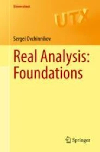- About MAA
- Membership
- MAA Publications
- Periodicals
- Blogs
- MAA Book Series
- MAA Press (an imprint of the AMS)
- MAA Notes
- MAA Reviews
- Mathematical Communication
- Information for Libraries
- Author Resources
- Advertise with MAA
- Meetings
- Competitions
- Programs
- Communities
- MAA Sections
- SIGMAA
- MAA Connect
- Students
- MAA Awards
- Awards Booklets
- Writing Awards
- Teaching Awards
- Service Awards
- Research Awards
- Lecture Awards
- Putnam Competition Individual and Team Winners
- D. E. Shaw Group AMC 8 Awards & Certificates
- Maryam Mirzakhani AMC 10 A Awards & Certificates
- Two Sigma AMC 10 B Awards & Certificates
- Jane Street AMC 12 A Awards & Certificates
- Akamai AMC 12 B Awards & Certificates
- High School Teachers
- News
You are here
Real Analysis: Foundations

Publisher:
Springer
Publication Date:
2021
Number of Pages:
190
Format:
Paperback
Series:
Universitext
Price:
54.99
ISBN:
978-3-030-64700-1
Category:
Textbook
[Reviewed by , on ]
John Ross
01/6/2023
In Real Analysis: Foundations, Sergei Ovchinnikov offers a commendable, if somewhat dense, overview of the theoretical underpinnings of Real Analysis. As the author makes clear, the aim of this text is to offer a self-contained, complete, and concise treatise on the theory involving the foundational work of Real Analysis. As such, it is not a text I would recommend for a first-time explorer of Real Analysis, but one that I would happily recommend to someone already familiar with the topics in RA and who is looking for an overview of the theoretical bedrock of the subject.
The text is incredibly slim; my physical copy is 178 pages, and will certainly be the skinniest analysis text on my bookshelf. Included in this thin profile are two chapters on number systems (Rational Numbers and Real Numbers), four chapters on the core Real Analysis topics (Continuous functions, Differentiation, Integration, and Infinite Series); and three appendices (one on the properties of the natural numbers and the integers; one on Dedekind cuts; and one giving an overview of ordered fields). Each of the six main chapters in the text averages approximately 25 pages, including some space for exercises that appear at the end of each chapter.
The material is introduced in a theory-first manner, with an aim of being self-consistent and complete. The result is beautiful for someone who already knows the roadmap, but will likely leave novices a little lost for direction. For example, the real numbers are introduced for the first time in Section 2.3, both via a construction (of equivalence classes of Cauchy sequences of real numbers), and as the unique Dedekind complete ordered field. To reach this point, Ovchinnikov introduces convergent sequences and Cauchy sequences in Section 1.5 (primarily through the example of rational numbers); then pivots to discussing Dedekind complete ordered fields and Cauchy completion of ordered fields in Section 2.1 and 2.2, respectively. Would I appreciate this approach when learning about Real Numbers for the first time? Perhaps not. Do I enjoy it now, with my familiarity with Real Analysis? Absolutely.
Ovchinnikov recognizes this, stating that the intended audience of the text is “upper-undergraduate students and lower-graduate students interested in the foundations of Real Analysis.” I tend to agree with his assessment of the text’s appeal. The proofs present in the text are “elementary” in some sense but require a technical prowess that a first-time explorer of real analysis would probably lack. Instead, this text is best used by someone already quite mathematically mature, looking to further their own understanding of the Real Analysis landscape through self-study.
John Ross is an assistant professor of mathematics at Southwestern University.
See the publisher's website.
- Log in to post comments




